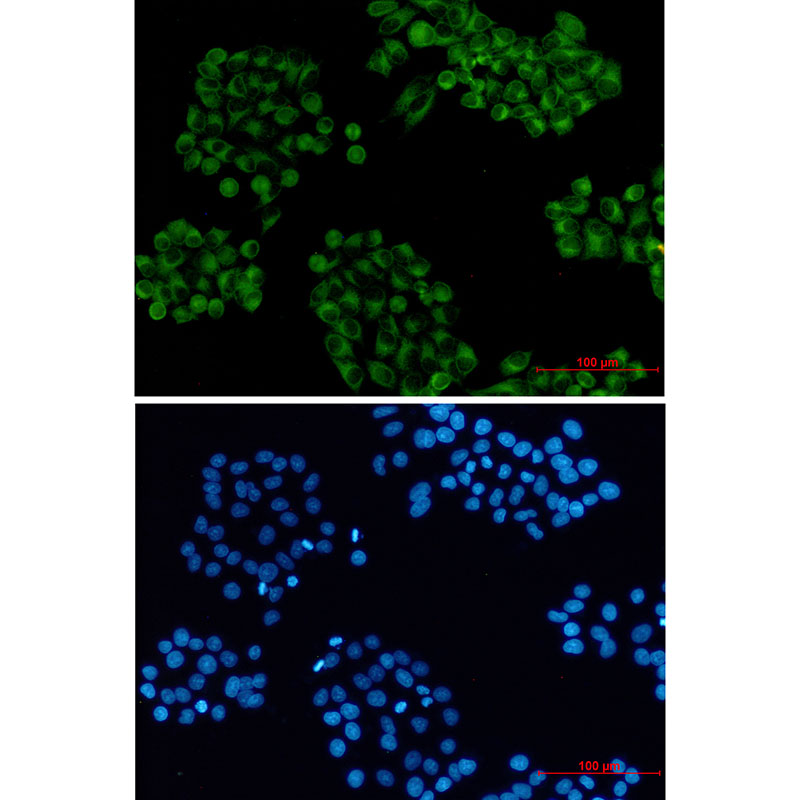

| WB | 1/500-1/1000 | Human,Mouse,Rat |
| IF | 1/20 | Human,Mouse,Rat |
| IHC | 咨询技术 | Human,Mouse,Rat |
| ICC | 1/50-1/200 | Human,Mouse,Rat |
| FCM | 咨询技术 | Human,Mouse,Rat |
| Elisa | 咨询技术 | Human,Mouse,Rat |
| Aliases | CEB; Cellubrevin; Synaptobrevin 3; VAMP3 |
| Entrez GeneID | 9341 |
| WB Predicted band size | Calculated MW: 11 kDa; Observed MW: 11 kDa |
| Host/Isotype | Rabbit IgG |
| Antibody Type | Primary antibody |
| Storage | Store at 4°C short term. Aliquot and store at -20°C long term. Avoid freeze/thaw cycles. |
| Species Reactivity | Human |
| Immunogen | Recombinant protein of human Cellubrevin |
| Formulation | Purified antibody in TBS with 0.05% sodium azide,0.05%BSA and 50% glycerol. |
+ +
以下是3-4篇关于Cellubrevin(VAMP3)抗体的经典文献及其摘要:
---
1. **文献名称**:*Cellubrevin is a ubiquitous tetanus-toxin substrate homologous to a putative synaptic vesicle fusion protein*
**作者**:T. Galli, A. Zahraoui, D. Louvard, J. P. Thiery
**摘要**:本研究首次鉴定了Cellubrevin(VAMP3),证明其广泛分布于非神经元细胞中,并通过抗体验证其与破伤风毒素敏感性的关联,提示其在囊泡运输中的保守作用。
2. **文献名称**:*A role of vesicle-associated membrane protein 3 (cellubrevin) in regulated exocytosis revealed by antibodies affecting vesicle positioning*
**作者**:R. J. Advani, H. R. Bae, J. B. Bock, D. Chao, Y. Doung, R. Prekeris, S. Yoo
**摘要**:通过特异性Cellubrevin抗体阻断实验,揭示VAMP3在内分泌细胞分泌囊泡定位中的关键作用,表明其参与调节型胞吐的分子机制。
3. **文献名称**:*Mechanisms of synaptic vesicle exocytosis mediated by SNARE proteins*
**作者**:T. Söllner, M. K. Bennett, S. W. Whiteheart, R. H. Scheller, J. E. Rothman
**摘要**:该研究利用Cellubrevin抗体等工具,证明SNARE复合体(含VAMP家族蛋白)是囊泡融合的核心驱动因子,为神经元与非神经元细胞膜融合机制提供直接证据。
4. **文献名称**:*Cellubrevin-dependent fusion of intracellular transport vesicles with the plasma membrane*
**作者**:H. T. McMahon, M. Missler, T. Söllner
**摘要**:通过抗体干扰实验,证实Cellubrevin在细胞内运输囊泡与质膜融合中的必要性,并揭示其在质膜修复和细胞更新中的生理意义。
---
这些文献涵盖了Cellubrevin抗体的早期发现与功能验证,以及其在囊泡运输、胞吐作用及膜修复研究中的关键应用。
Cellubrevin, also known as VAMP3 (vesicle-associated membrane protein 3), is a member of the SNARE (soluble N-ethylmaleimide-sensitive factor attachment protein receptor) protein family involved in intracellular membrane fusion events. It is ubiquitously expressed and primarily localized to recycling endosomes and secretory vesicles, playing a critical role in vesicle trafficking, exocytosis, and plasma membrane repair. Cellubrevin facilitates the fusion of vesicles with target membranes by forming SNARE complexes with syntaxin and SNAP-25 homologs, enabling cargo release or membrane component recycling.
Antibodies targeting cellubrevin are widely used in research to study vesicular transport mechanisms, particularly in non-neuronal cells where it complements the function of its neuronal homologs (e.g., synaptobrevin/VAMP2). These antibodies are essential tools for techniques such as Western blotting, immunofluorescence, and immunoprecipitation to visualize subcellular localization, quantify expression levels, or identify interacting partners. Studies utilizing cellubrevin antibodies have contributed to understanding pathologies linked to trafficking defects, including metabolic disorders (e.g., insulin-regulated GLUT4 translocation in diabetes) and neurological conditions. Additionally, they help investigate cellular processes like cytokinesis, receptor recycling, and immune cell secretion. Commercial cellubrevin antibodies are typically raised against specific epitopes, such as the N-terminal or conserved SNARE domains, with validation in knockout models ensuring specificity. Their application continues to advance insights into membrane dynamics and therapeutic targeting of vesicle-mediated pathways.
×